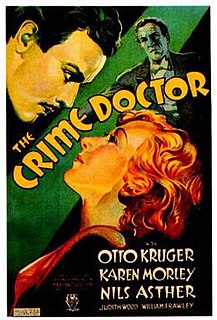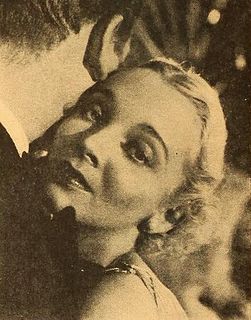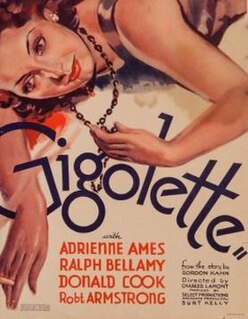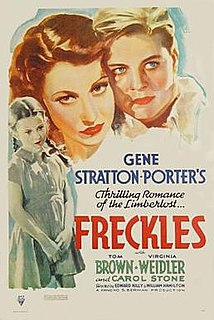Related Research Articles

The Seventh Victim is a 1943 American horror film noir directed by Mark Robson and starring Tom Conway, Jean Brooks, Isabel Jewell, Kim Hunter, and Hugh Beaumont. Written by DeWitt Bodeen and Charles O'Neal, and produced by Val Lewton for RKO Radio Pictures, the film focuses on a young woman who stumbles on an underground cult of devil worshippers in Greenwich Village, New York City, while searching for her missing sister. It marks Robson's directorial debut and was Hunter's first onscreen role.

The Royal Bed is a 1931 American pre-Code satirical comedy film produced by William LeBaron and distributed through RKO. The film was directed by and starred Lowell Sherman, along with Mary Astor and Anthony Bushell. The screenplay was adapted by J. Walter Ruben based on the 1928 play by Robert E. Sherwood titled The Queen's Husband. It would be one of a handful of RKO pictures which was produced in both English and French language versions.

White Shoulders is a lost 1931 American pre-Code comedy-drama film directed by Melville W. Brown and starring Mary Astor and Jack Holt, with major supporting roles by Ricardo Cortez and Sidney Toler. The film was produced and distributed by RKO Pictures. The screenplay by Jane Murfin and J. Walter Ruben was adapted from Rex Beach's short story, The Recoil.

Beyond Victory is a 1931 American pre-Code war film starring Bill Boyd, James Gleason, Lew Cody, and ZaSu Pitts. While John Robertson received directing credit, Edward H. Griffith supposedly took extensive re-takes after production ended and the film was deemed not audience ready. Two actresses with major roles in the original version were completely cut from the final release, Helen Twelvetrees and June Collyer. The original screenplay was written by Horace Jackson and James Gleason. While the film might not have made a profit at the box office, it was well received by critics.

The Crime Doctor is a 1934 American crime drama directed by John Robertson from a screenplay by Jane Murfin, adapted from the novel The Big Bow Mystery by Israel Zangwill. The film stars Otto Kruger, Karen Morley, and Nils Asther. RKO Radio Pictures produced and distributed the film which was released on April 27, 1934.

Adventure Girl is a 1934 American adventure documentary directed by Herman C. Raymaker, based on dialogue written by Ferrin Frazier, starring and narrated by Joan Lowell. The screenplay is based on the autobiography of Lowell, The Cradle of the Deep, which later turned out to be a work of fiction.

Dangerous Corner is a 1934 American mystery film directed by Phil Rosen, using a screenplay by Anne Morrison Chapin, Madeleine Ruthven, Ralph Berton, and Eugene Berton, which was based on a novel and play of the same name by J. B. Priestley. It starred Virginia Bruce, Conrad Nagel, and Melvyn Douglas.

By Your Leave is a 1934 American domestic comedy film directed by Lloyd Corrigan from a script by Allan Scott, Lewis Foster, and Sam Mintz. The screenplay was based on a play of the same name by Gladys Hurlbut and Emma B. C. Wells, which had a short run early in the year at the Morosco Theatre. The film was produced by Pandro S. Berman, and starred Frank Morgan and Genevieve Tobin, although several other actresses were initially scheduled to appear in the film, including Mary Astor and Ann Harding. Both stars were on loan to RKO from other studios. It marked the film debuts of two notable Broadway actors, Glenn Anders and Gene Lockhart, the latter of which had a lengthy Hollywood career. By Your Leave opened on November 9, 1934, and received mostly positive reviews.

Gigolette is a 1935 American romance film directed by Charles Lamont from a screenplay and story by Gordon Kahn. The film stars Adrienne Ames, Ralph Bellamy, Donald Cook, and Robert Armstrong.

A Dog of Flanders is a 1935 American drama film directed by Edward Sloman, based on a screenplay by Ainsworth Morgan from the story by Dorothy Yost, which she adapted from the 1872 novel of the same name by Ouida. The film stars Frankie Thomas, appearing in only his second film.

Chasing Yesterday is a 1935 American historical drama film directed by George Nicholls Jr. using a screenplay by Francis Edward Faragoh, adapted from the 1881 novel Le Crime de Sylvestre Bonnard, by Anatole France. Released on May 3, 1935, the film stars Anne Shirley, O. P. Heggie, and Helen Westley.

The Arizonian is a 1935 American Western film directed by Charles Vidor and starring Richard Dix, Margot Grahame, Preston Foster, and Louis Calhern. The screenplay was by Dudley Nichols. The film was released by RKO Radio Pictures on June 28, 1935.

Freckles is a 1935 American drama film directed by Edward Killy and William Hamilton from a screenplay written by Dorothy Yost, adapted by Mary Mayes from Gene Stratton-Porter's 1904 novel of the same name. Two earlier adaptations of Stratton-Porter's novel had been produced, the first by Paramount in 1917, and the second in 1928 by FBO, both were also titled Freckles. This 1935 version was released by RKO Radio Pictures on October 4, and stars Tom Brown, Virginia Weidler, and Carol Stone.

Criminal Lawyer is a 1937 American drama film directed by Christy Cabanne from a screenplay by G. V. Atwater and Thomas Lennon, based on a story by Louis Stevens. The film stars Lee Tracy, Margot Grahame and Eduardo Ciannelli. RKO produced the film and premiered it on January 26, 1937 in New York City, with a national release a few days later on January 29. It was the second time Stevens' story had been used for a film, the first being 1932's State's Attorney, starring John Barrymore and Helen Twelvetrees, directed by George Archainbaud, and also produced and released by RKO.

Conspiracy is a 1939 American spy drama film directed by Lew Landers, from a screenplay by Jerome Chodorov, based on the story, "Salute to Hate", by John McCarthy and Faith Thomas. The film stars Allan Lane, Linda Hayes, and Robert Barrat, and was produced and distributed by RKO Radio Pictures, who premiered the film in New York City on August 23, 1939, with a general release on September 1.
Gildersleeve's Bad Day is a 1943 American comedy film directed by Gordon Douglas from a screenplay by Jack Townley. The picture was the second in the Gildersleeve's series produced and distributed by RKO Radio Pictures, based on the popular NBC radio program, The Great Gildersleeve, created by Leonard L. Levinson, and was released on June 10, 1943. The film stars Harold Peary, Jane Darwell and Nancy Gates.
Maury Cohen, also known as Maury M. Cohen, was an American film producer most active during the 1930s. He owned one of the Poverty Row studios, Invincible films, which specialized in making low-budget feature films. After leaving film in the early 1940s, Cohen founded and ran the historic dance club in Los Angeles, the Hollywood Palladium.
Arthur T. Horman was an American screenwriter whose career spanned from the 1930s to the end of the 1950s. During that time he wrote the stories or screenplays for over 60 films, as well as writing several pieces for television during the 1950s.

Samuel J. Briskin was one of the foremost producers of Hollywood's Golden Age, and head of production during his career at three of the "Big 8" major film studios: Columbia Pictures (twice), Paramount Pictures, and RKO Pictures. In the late 1950s, he was briefly on the board of directors of another major, Metro-Goldwyn-Mayer. During World War II, Briskin served in the army's Signal Corps as a film producer, attaining the rank of lieutenant colonel. After the war he co-founded Liberty Films with Frank Capra. They were later joined by William Wyler and George Stevens. The studio only produced two films, but both are now considered classics: It's a Wonderful Life and State of the Union. All three of his brothers were also film producers, as well as one of his sons, and his sister was married to the eventual Chairman of Columbia, where Briskin spent the last decade of his life as a vice-president and head of production until his death in 1968 from a heart attack.
Lee Marcus, also known as Lee S. Marcus, was an American film producer of the 1930s and 1940s. During his fifteen-year career he produced over 85 films, most of them between 1934 and 1941 while he was at RKO Studios. Prior to his production career, Marcus worked for FBO and then RKO as a sales executive, reaching the level of vice president in both organizations. At RKO, he was head of production of the studio's b-films during the late 1930s and the beginning of the 1940s. He was also responsible for producing what many consider to be the first film noir, 1940's Stranger on the Third Floor.
References
- ↑ "Grand Old Girl: Detail View". American Film Institute. Archived from the original on March 29, 2014. Retrieved September 9, 2014.
- ↑ "Record Activity at RKO Studios". The Film Daily. September 22, 1934. pp. 1, 3. Retrieved January 3, 2017.

- ↑ "Productions in Work". Motion Picture Herald. October 6, 1934. p. 55. Retrieved January 6, 2017.

- ↑ McCarthy, Gus (October 27, 1934). "The Cutting Room". Motion Picture Herald. p. 39. Retrieved January 6, 2017.

- ↑ "News of Day". The Film Daily. November 14, 1934. p. 7. Retrieved January 3, 2017.

- ↑ "The Release Chart". Motion Picture Herald. December 29, 1934. p. 90. Retrieved January 6, 2017.

- ↑ "RKO Picture for Astor". The Film Daily. February 9, 1936. p. 2. Retrieved January 3, 2017.

- ↑ "RKO Closes GB Circuit Deal". The Film Daily. March 15, 1936. p. 12. Retrieved January 3, 2017.

- ↑ "Reviews of the New Features". The Film Daily. January 9, 1935. p. 11. Retrieved January 3, 2017.

- ↑ "Motion Picture Daily's Hollywood Preview". Motion Picture Daily. December 3, 1934. p. 7. Retrieved January 3, 2017.

- ↑ Daly, Phil M. (November 20, 1934). "Along the Rialto". The Film Daily. p. 3. Retrieved January 3, 2017.

- ↑ Daly, Phil M. (January 12, 1935). "Along the Rialto". The Film Daily. p. 4. Retrieved January 3, 2017.
